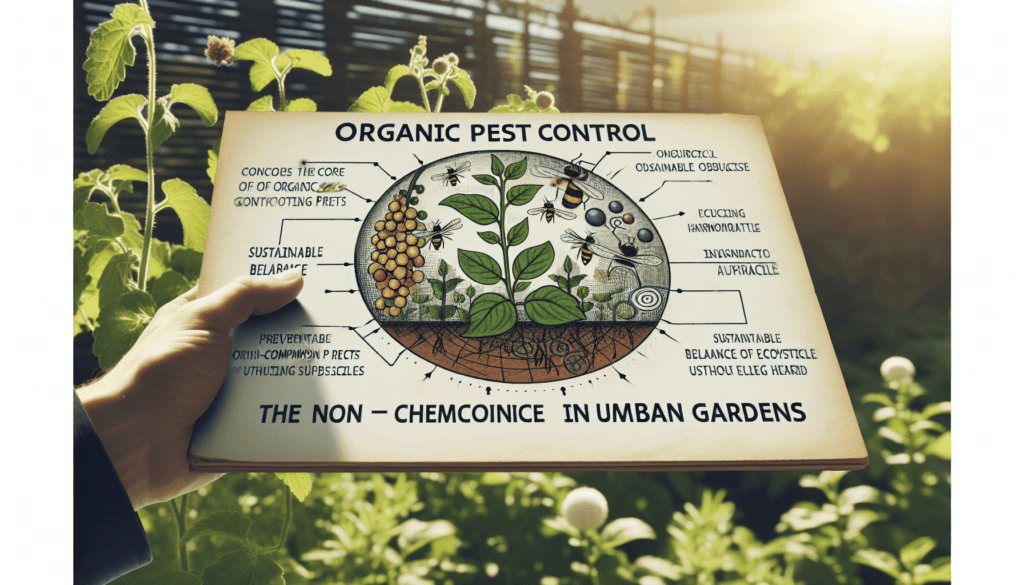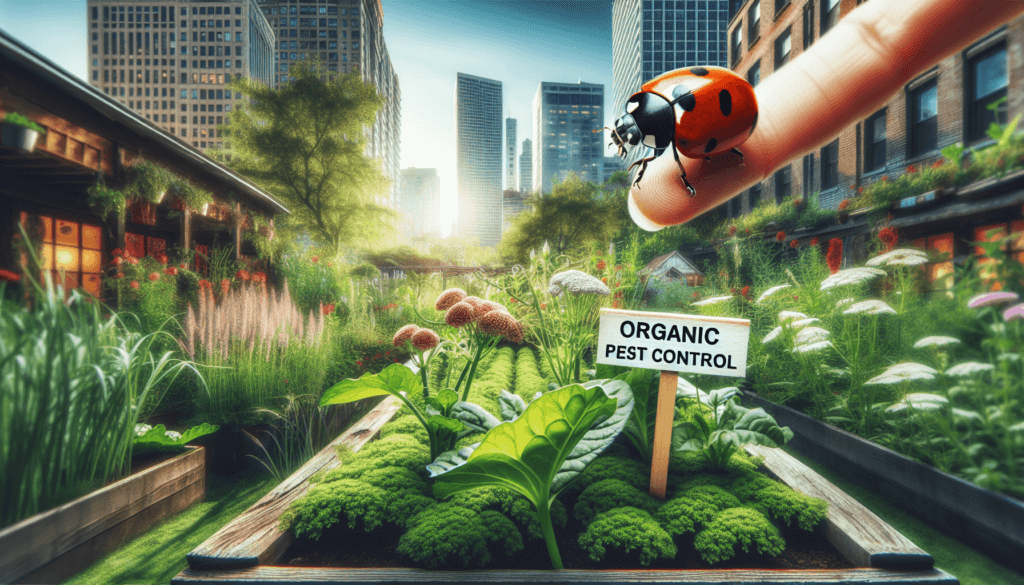If you’re an urban gardener, you know the constant battle against pests can be quite frustrating. But fear not, because there are natural solutions to help you keep those pesky insects at bay. From planting companion plants to using homemade pest repellents, this article will provide you with the best ways to control common urban garden pests naturally. With these tips, you can create a thriving garden that is free from destructive critters, all while maintaining a friendly environment for yourself and your plants. So let’s explore these eco-friendly methods and discover how you can protect your urban oasis without harming the ecosystem.

Companion Planting
Definition of companion planting
Companion planting is a gardening practice where certain plants are grown together to enhance their growth and protect each other from pests and diseases. It involves strategically placing plants that have mutually beneficial relationships with one another to create a harmonious garden ecosystem. By selecting compatible plants, you can maximize the overall health and productivity of your garden.
Benefits of companion planting
Companion planting offers numerous benefits to your garden. Firstly, it helps deter pests naturally. Certain plant combinations repel or confuse pests, making it harder for them to find their target plants. Additionally, some plants release natural compounds that act as repellents or attract predators that feed on garden pests, providing a natural and sustainable pest control method.
Companion planting also enhances soil fertility and nutrient availability. Some plants have the ability to fix nitrogen in the soil, enriching it and benefiting their neighboring plants. Additionally, deep-rooted plants can help break up compacted soil, improving drainage and nutrient uptake for other plants.
Another advantage of companion planting is optimizing space utilization. By intercropping compatible plants, you can make the most of your garden beds. Tall plants can provide shade or support for climbing crops, and groundcover plants can suppress weed growth and retain soil moisture.
Examples of beneficial companion plants
There are numerous combinations of beneficial companion plants that you can try in your garden. For instance, planting marigolds alongside tomatoes can help repel nematodes that attack tomato roots. Similarly, planting basil near tomatoes not only deters pests like aphids and tomato hornworms but also improves the flavor of the tomatoes.
Other examples include planting chives or onions near carrots to repel carrot flies and planting nasturtiums near cucumbers to deter cucumber beetles. Additionally, planting beans near corn can mutually benefit the plants as beans fix nitrogen in the soil, providing a nutrient boost to corn.
By incorporating these companion planting strategies, you can create a thriving and pest-resistant garden while enjoying the beauty and functionality of diverse plant combinations.
Attracting Predators
Identifying common garden predators
Understanding the common predators in your garden is essential for effective pest management. Some common garden predators include ladybugs, lacewings, hoverflies, praying mantises, spiders, birds, and bats. These beneficial creatures play a crucial role in controlling garden pests by feeding on them or their eggs.
Creating habitats to attract predators
To attract beneficial predators to your garden, it is crucial to provide them with suitable habitats. One way to do this is by incorporating diverse native plants that provide food and shelter for predators. Native flowering plants can attract pollinators and beneficial insects, while shrubs and trees can serve as nesting sites for birds.
You can also create specific habitats, such as building bug hotels, birdhouses, or bat boxes. Bug hotels are structures made from natural materials like logs, twigs, and pinecones, which provide hiding places and nesting sites for beneficial insects like ladybugs and lacewings. Birdhouses and bat boxes can attract birds and bats that feed on garden pests.
Plants that attract beneficial insects and birds
Planting certain species of flowers and herbs can help attract beneficial insects and birds to your garden. Flowers such as marigolds, sunflowers, zinnias, and asters are known to attract pollinators like bees and butterflies, which in turn attract predatory insects.
In addition to flowers, herbs like dill, fennel, cilantro, and parsley can also attract beneficial insects such as ladybugs and hoverflies. These insects are natural predators of aphids, mealybugs, and other common garden pests.
By incorporating these plants into your garden, you can create an inviting habitat for beneficial insects and birds, contributing to a healthier and more balanced ecosystem.
Mechanical Barriers
Using physical barriers to deter pests
Mechanical barriers are physical structures or materials used to prevent pests from accessing your plants. These barriers physically block pests or create a physical barrier that pests cannot pass through. Using barriers is an effective way to protect your plants, especially against pests like rabbits, deer, birds, and insects.
Types of barriers (fences, netting, row covers)
There are various types of mechanical barriers that you can use in your garden. Fences are commonly used to deter larger pests such as deer or rabbits. Ensure that the fence is tall enough to prevent animals from jumping over and that it extends below ground to prevent them from burrowing underneath.
Netting is an excellent barrier for protecting against birds, insects, and larger pests. It can be draped over plants or used to create enclosures around specific areas. Make sure the mesh is fine enough to exclude the pests you are targeting.
Row covers are lightweight fabric covers that can be placed directly over plants to protect them from insects and other pests. They allow sunlight and moisture to reach the plants while preventing pests from coming into contact with them.
Proper installation and maintenance of barriers
For barriers to be effective, proper installation and regular maintenance are necessary. Ensure that fences are firmly secured in the ground and that there are no gaps or holes that could allow pests to enter. Regularly inspect fences, netting, and row covers for any damage and repair or replace them as needed.
When using row covers, it is essential to remove them periodically to allow for pollination or to avoid excessive heat buildup. This can be done during the flowering stage for plants that require pollination, or during periods of hot weather, to prevent heat stress.
By utilizing mechanical barriers correctly and maintaining them regularly, you can provide an effective physical defense against pests and safeguard your plants.
Organic Sprays and Solutions
Natural homemade pest sprays
Natural homemade pest sprays are a great alternative to chemical pesticides. They are safe, environmentally friendly, and easy to make. Here are a few recipes for homemade sprays that can help control common garden pests:
Neem oil spray: Mix neem oil with water and a mild liquid soap. Neem oil acts as an effective insect repellent and disrupts the lifecycle of pests like aphids, whiteflies, and spider mites.
Garlic spray: Crush several garlic cloves and soak them in water overnight. Strain the mixture, add liquid soap, and dilute with water. Garlic spray works as a repellant against a wide range of pests, including aphids, caterpillars, and beetles.
Soap spray: Mix a tablespoon of liquid soap with a quart of water. Soap spray is effective against soft-bodied pests like aphids, mealybugs, and spider mites.
Commercial organic pest control products
If you prefer ready-to-use solutions, there are many commercial organic pest control products available. Look for products that contain natural ingredients like plant oils, essential oils, and beneficial bacteria. These products are formulated to target specific pests while minimizing harm to beneficial insects and the environment.
Before purchasing any product, make sure to read and follow the label instructions carefully. Each product may have specific application rates, target pests, and safety precautions.
Correct application and timing for maximum effectiveness
To achieve maximum effectiveness with organic sprays and solutions, it is crucial to apply them correctly and at the right time. Spray your plants thoroughly, ensuring that both the upper and lower surfaces of the leaves are covered. Pay close attention to areas where pests are most commonly found, such as the undersides of leaves or along the stems.
Timing is also critical. Apply sprays early in the morning or late in the evening when temperatures are cooler, as this reduces the risk of leaf burn and allows the sprays to dry before the sun is at its strongest. Additionally, it is essential to reapply sprays after rainfall or as directed on the label to maintain their effectiveness.
By following these guidelines, you can effectively control garden pests using organic sprays and solutions while minimizing harm to beneficial insects and the environment.

Crop Rotation
Explanation of crop rotation
Crop rotation is the practice of systematically changing the types of crops grown in a specific area of your garden each year. It involves grouping plants with similar characteristics or life cycles together and then rotating them to a different area or bed in subsequent years.
Benefits of crop rotation
Crop rotation offers several benefits for pest control and overall garden health. Firstly, it helps break pest and disease cycles. Many pests and diseases have specific plant hosts, and by rotating crops, you disrupt their life cycles by denying them their preferred food source. This reduces the buildup of pests and diseases in the soil over time.
Additionally, crop rotation helps improve soil fertility and nutrient balance. Different plant families have different nutrient requirements and take up nutrients from the soil at varying rates. By rotating crops, you can prevent soil nutrient depletion and ensure that each crop receives the right balance of nutrients.
Furthermore, crop rotation can help reduce weed pressure. Some weed species have specific plant hosts, and by rotating crops, you can disrupt their life cycles and reduce weed populations.
Effective crop rotation strategies
To implement effective crop rotation, follow these strategies:
Group plants with similar characteristics or life cycles together. For example, group plants from the same family or those that have similar nutrient requirements or growth habits.
Create a rotation plan that spans multiple years, ideally three to four years. This ensures that each crop has sufficient time away from its previous location to break pest and disease cycles effectively.
Avoid planting crops from the same family in consecutive years in the same area. Instead, rotate them to a different bed or part of your garden.
Incorporate cover crops in your rotation plan. Cover crops such as legumes or grasses can help improve soil fertility, suppress weeds, and break pest cycles.
By implementing a well-planned crop rotation strategy, you can effectively manage pests and diseases, enhance soil fertility, and maintain a healthy and productive garden.
Soil Health and Amendments
Importance of healthy soil in pest control
Healthy soil is the foundation of a thriving garden and plays a vital role in pest control. Maintaining healthy soil is essential because it supports the growth of strong, vigorous plants that are more resilient to pests and diseases. Healthy soil also promotes beneficial soil organisms that help control harmful pests naturally.
Methods to improve soil health
To improve soil health, consider the following methods:
Mulching: Apply organic mulch, such as straw, wood chips, or compost, to help retain moisture, suppress weeds, and add organic matter to the soil. Organic mulch breaks down over time, enriching the soil and enhancing its fertility.
Composting: Start a compost pile or bin to recycle kitchen scraps and yard waste into nutrient-rich compost. Compost improves soil structure, increases water retention, and provides a steady supply of essential nutrients to your plants.
Vermicomposting: Use worms to break down organic waste into nutrient-rich vermicompost. Vermicompost is an excellent soil amendment that improves soil fertility and structure.
Avoid over-tilling: Over-tilling can damage the soil structure and disrupt the balance of beneficial soil organisms. Instead, practice minimal tillage or no-till gardening to preserve soil health.
Using amendments to deter pests (neem cake, diatomaceous earth)
Certain soil amendments can help deter pests by creating unfavorable conditions for them. Neem cake is a byproduct of neem oil extraction and is rich in natural compounds that repel insects. Adding neem cake to the soil not only helps control soil-borne pests like nematodes and fungi but also improves soil fertility.
Diatomaceous earth is another effective amendment that controls pests like slugs, snails, and certain insects. It is made from the fossilized remains of algae and is abrasive to pests, causing damage to their exoskeletons.
When using soil amendments, follow the recommended application rates and guidelines provided by the manufacturers. Additionally, ensure that you incorporate amendments into the soil thoroughly to maximize their effectiveness.
By prioritizing soil health and using appropriate amendments, you can create an environment that naturally deters pests and promotes strong, healthy plant growth.

Beneficial Nematodes
Introduction to beneficial nematodes
Beneficial nematodes are microscopic roundworms that help control a variety of garden pests. They prey on insects, insect larvae, and soil-dwelling pests, providing a natural and effective form of pest control.
Types of pests controlled by nematodes
Beneficial nematodes are particularly effective against pests like grubs, caterpillars, weevils, and soil-dwelling insects. They can also target pest larvae in the soil, preventing them from maturing and causing damage to plants.
Application methods for nematode control
Beneficial nematodes can be applied to the soil using two methods: drenching and foliar application.
Drenching involves mixing the nematodes with water and applying the solution to the soil using a watering can or sprayer. This method is effective for targeting pests that dwell in the soil or close to the soil surface.
Foliar application is suitable for pests that feed on plant foliage. The nematodes are mixed with water and sprayed directly onto the plants, ensuring thorough coverage of the foliage.
When applying nematodes, follow the instructions provided with the product carefully. The success of nematode control depends on factors such as temperature, moisture levels, and pest population density. Applying them during the recommended time and under optimal conditions will increase their effectiveness in controlling pests.
By incorporating beneficial nematodes into your pest control strategy, you can naturally and effectively combat a wide range of garden pests.
Biological Control Agents
Introduction to biological control agents
Biological control agents are living organisms that control pests by preying on them or disrupting their lifecycle. They are an environmentally friendly and sustainable alternative to chemical pesticides. Various biological control agents can be used in the garden to manage both common and specialized pests.
Beneficial insects for pest control
Many beneficial insects feed on pests and contribute to garden pest control. Ladybugs, also known as lady beetles, are voracious predators of aphids and other soft-bodied insects. Lacewings are effective predators of aphids, caterpillars, and other garden pests. Hoverflies and parasitic wasps are known to prey on aphids, caterpillars, and other soft-bodied insects as well.
Certain beetles, such as ground beetles and soldier beetles, are beneficial as they feed on slugs, snails, caterpillars, and other pests. Praying mantises are also effective insect predators that can help control a wide range of garden pests.
How to attract and release beneficial insects
To attract and release beneficial insects into your garden, consider the following strategies:
Plant a diverse range of flowering plants and herbs. These provide nectar and pollen for beneficial insects, attracting them to your garden.
Create a water source, such as a small shallow bowl or birdbath, to provide drinking water for beneficial insects.
Avoid using broad-spectrum insecticides, as these can harm beneficial insects along with pests.
Purchase and release beneficial insects into your garden. You can buy them from reputable suppliers who specialize in biological control agents. Follow the instructions provided with the insects to ensure successful release and establishment.
By attracting and fostering populations of beneficial insects, you can naturally maintain a balanced ecosystem in your garden and reduce the need for chemical pesticides.

Natural Traps
Types of natural traps for pests
Natural traps are effective tools for controlling specific pests in your garden. They can be made from readily available materials and provide an environmentally friendly solution to pest problems. Here are a few types of natural traps:
Beer traps: Shallow bowls or containers filled with beer can attract and drown slugs and snails. These pests are attracted to the yeast in beer and will crawl into the traps.
Fruit fly traps: Fruit flies can be controlled by placing vinegar or a mixture of vinegar and dish soap in a container with a small opening. Fruit flies are attracted to the scent of vinegar and will be trapped in the container.
Sticky traps: Yellow or blue sticky traps can attract and capture flying insects like aphids, whiteflies, and gnats. These traps are coated with a sticky substance that traps the insects when they come into contact with it.
How to construct and use traps effectively
Constructing and using traps effectively requires attention to detail and proper placement. When constructing traps, ensure that they are sturdy and well-designed to capture the specific pests you are targeting.
Place traps in areas where pests are most active or where damage is occurring. For example, beer traps can be placed near plants that are susceptible to slug or snail damage. Fruit fly traps should be placed near areas where fruit or vegetables are ripening.
Regularly check and empty traps to prevent the buildup of pests. Replace or replenish bait as needed to maintain the effectiveness of the traps.
Trapping specific pests (slugs, snails, fruit flies)
Different pests require specific traps for effective control. For slugs and snails, use beer traps, as mentioned earlier. Place shallow containers filled with beer at ground level near plants they are likely to attack.
To control fruit flies, construct vinegar traps by filling a small container with vinegar or a mixture of vinegar and dish soap. Cover the container with plastic wrap and poke small holes in it. The fruit flies will be attracted to the scent of vinegar and get trapped inside.
For flying pests like aphids, whiteflies, or gnats, use sticky traps. Hang or place these traps near infested plants, ensuring that they are at the same height as the plants.
By utilizing the appropriate traps for specific pests, you can effectively control them without relying on chemical pesticides.
Proper Planting and Maintenance
Choosing pest-resistant plant varieties
Selecting pest-resistant plant varieties is an essential step in preventing and managing garden pests. Different plant varieties have varying levels of resistance to pests and diseases. Look for plant varieties that are specifically bred or known for their resistance to common garden pests in your area.
Consult local garden centers, nurseries, or cooperative extension offices to get recommendations for pest-resistant plant varieties that are well-suited for your region.
Proper spacing and pruning techniques
Proper spacing and pruning techniques contribute to good airflow and sunlight penetration, reducing the risk of pest and disease problems. Overcrowded plants are more susceptible to pests and diseases due to limited airflow, which can create a humid and favorable environment for pests and pathogens.
When planting, ensure that you provide adequate spacing between plants to allow for proper air circulation. Regularly thin out overcrowded plants and remove any dead or diseased plant material.
Pruning can also help manage pests by removing infested or damaged plant parts before pests can spread. Remove any affected leaves or branches and dispose of them properly.
Regular inspection and early pest detection
Regular inspection and early pest detection are crucial for effective pest management. Regularly monitor your plants for signs of pest damage, such as chewed leaves, wilting, or discoloration.
Check the undersides of leaves, stems, and along the plant surface for any signs of pests or eggs. Pay close attention to new growth, as pests often target young and tender plant parts.
By detecting pests early, you can take prompt action to control them before they cause significant damage to your plants. This can include handpicking pests, treating with organic sprays or solutions, or implementing other pest control strategies discussed earlier.
In conclusion, implementing a combination of these natural pest control strategies can help you maintain a healthy and thriving garden while minimizing the use of chemical pesticides. By incorporating companion planting, attracting predators, using mechanical barriers, utilizing organic sprays and solutions, implementing crop rotation, prioritizing soil health and amendments, utilizing beneficial nematodes and biological control agents, using natural traps, and practicing proper planting and maintenance techniques, you can create a balanced ecosystem that naturally controls common garden pests. So roll up your sleeves and get ready to enjoy a bountiful and pest-free garden!



